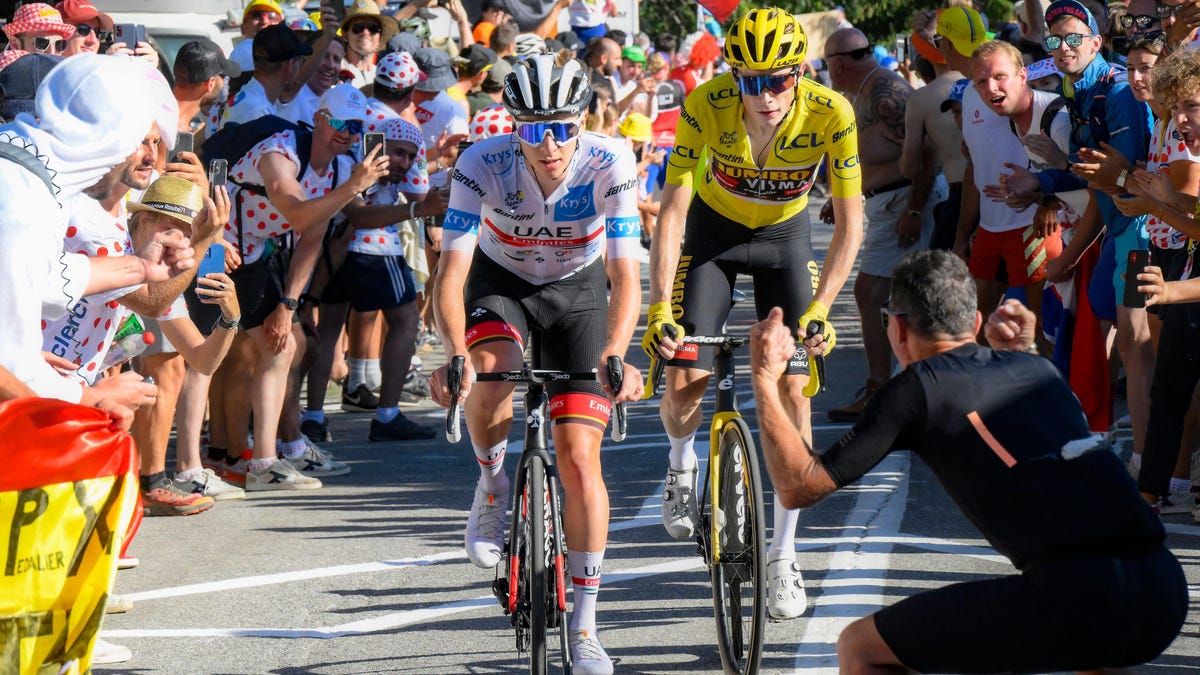Tour de France Pours Water on Roads to Keep Pavement From Melting in Unprecedented European Heat Wave

Photo: Bernard Papon / Pool / AFP (Getty Images)
Europe is in the midst of a dangerous, record-breaking heatwave. The Met Office, the United Kingdom’s national weather service, issued its first-ever red extreme heat warning as temperatures in parts of England are expected to exceed 104 degrees. On the other side of the English Channel, over 42,000 acres of land have been burned in wildfires across France, Spain and Portugal. The heatwave has also impacted this year’s Tour de France bicycle race.
The Tour de France is currently on its third and final rest day after 15 days of hard racing so far. The 2,000-mile long race has already featured a rider breaking his neck (but still finishing the stage) after colliding with an unaware spectator, a stage being temporarily halted by climate protesters blocking the route, and a dramatic battle for the leader’s yellow jersey.
Racing on public roads naturally involves contending with numerous unpredictable variables — traditionally, that’s part of what makes road racing exciting. But riding over melting pavement is not something that fans or riders were asking for in the most difficult bicycle race in the world. The melting road surfaces pose an obvious danger to riders, especially on curvy, high-speed sections of the route, where falls and massive crashes would become a near-certainty. However, the solution that Tour organizers have pursued isn’t popular with many onlookers.
Amaury Sport Organization (ASO), the Tour organizer, has chosen to spray melt-prone portions of the route with copious amounts of water to keep the pavement cool and intact. The organization allocated 10,000 liters (roughly 2,642 gallons) of water for pavement-cooling purposes. In light of the wildfires raging through Europe, ASO has had to clarify that it doesn’t intend to use its full allocation of water to cool a single stage of the race, after it was incorrectly assumed that all 10,000 liters would go toward cooling Stage 15, yesterday’s portion of the Tour.
G/O Media may get a commission
Pierre-Yves Thouault, the Deputy Director of the Tour, explained the situation to Le Parisien (link in French, translation below via automated translation software):
The reality is quite different and concerns only the safety of the riders. With the patrol truck that passes right in front of the caravan, we have identified zones that, end to end, would be between 150 and 200 meters of what we call bleeding zones. That is where, because of the heat, the tar melts and makes slippery runs on the road. There, they will be watered to cool them down. Otherwise the riders could slip on them and get hurt badly.
Course Manager André Bancala added:
So far, we’ve sprayed about 20 meters, which is about 50 liters of water spent. We’ve already targeted kilometer 190 as we approach the finish. There are some bends that may have been damaged. But at the most, we’re going to reach 350 liters. We’re on very little.
ASO has also stated that its total water usage so far is actually down compared to previous runnings of the Tour de France — in part because the opening three days of the 2022 Tour took place in Denmark, where ambient temperatures were relatively cooler.
The current leader in the general classification is Danish rider Jonas Vingegaard, who took the lead after Stage 11. Only six stages remain as the Tour ventures into the Pyrenees mountains along the Franco-Spanish border before heading to Paris.



